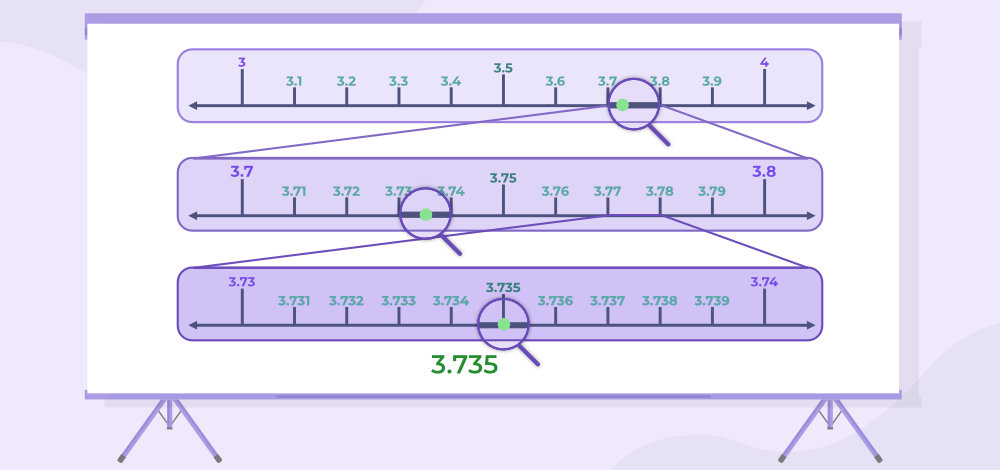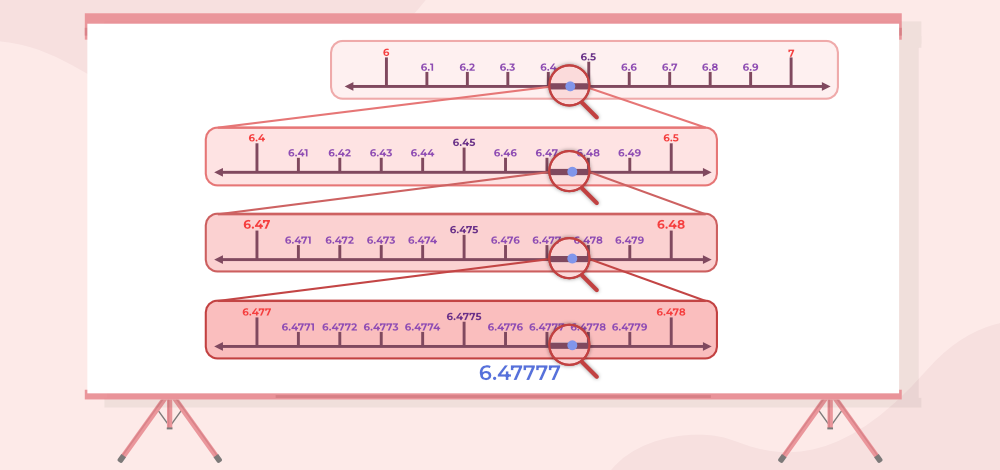In mathematics, we have various types of numbers, like natural numbers, whole numbers, integers, rational and irrational numbers, etc. A decimal number is one of them and is used to represent a whole number and a fraction together. In algebra, decimal numbers are a set of numbers that lie between integers on a number line.
A decimal number consists of a whole number part and a fractional part, which are separated by a point called a decimal point. A decimal number is classified into different types depending on the type of digits that come after the decimal point. Terminating decimals and non-terminating decimals are the two types of decimals, where a non-terminating decimal is further classified into non-terminating recurring decimals and non-terminating non-recurring decimals.
Terminating Decimals
A terminating decimal is referred to as a number that has a finite number of digits after the decimal point. For example, 0.125, 58.568, 135.05, 213.12345, etc. are examples of terminating decimals. After the decimal point, the digits can continue to repeat, but there must be an end. A terminating decimal can be written in p/q form, where p and q are integers and q is not equal to zero. For example, 0.125 can be expressed as 1/8 in p/q form.
Representation of Terminating Decimals on Number Line
Let us assume that we are looking for 3.735 on the number line. We know that 3.735 is somewhere between 3 and 4. So, let’s have a closer look at the number line between 3 and 4 in detail. Assume that we divided it into ten equal parts and labelled each division point as shown in the figure below. 3.1 is the first mark to the right of 3; the following numbers will be 3.2, 3.3, 3.4, and so on.
Now, let us focus on the space between 3.7 and 3.8. Again, assume that we divided it into ten equal parts and labelled each division point as shown in the figure below. 3.71 will be the first mark to the right of 3.7, and the following numbers will be 3.72, 3.73, 3.74, and so on. Again, 3.735 must be somewhere between 3.73 and 3.74. Again, assume that we divided it into ten equal parts and labelled each division point as shown in the figure below. 3.731 will be the first mark to the right of 3.73, and the following numbers will be 3.732, 3.733, 3.734, and so on. In this way, we can easily mark any terminating decimal on the number line.

Representation of Terminating Decimals on the Number Line
Non-Terminating Decimals
A non-terminating decimal is referred to as a number that has infinite digits after the decimal point. A non-terminating decimal is classified into two types, i.e.,
- Non-Terminating Recurring Decimals
- Non-Terminating Non-Recurring Decimals
Non-Terminating Recurring Decimals
A recurring decimal is a non-terminating decimal in which a digit or a sequence of numbers repeats itself after the decimal point without terminating. A non-terminating recurring decimal can be expressed in p/q form, where p and q are integers and q ≠ 0. 0.33333…, 1.666666…, 2.242424…, etc. are some examples of non-terminating recurring decimals.
Example: Express 2.757575… in p/q form.
Solution:
Given decimal is 2.666666…
let x = 2.75757575…
Here, we can observe that the numbers 75 are repeating. Since we have two digits repeating, let us multiply x with 100.
100x = 275.75757575…
100x = 273.75757575… + 2.75757575…
We know that x = 2.75757575…
So, 100x = 273+ x
100x − x = 273
99x = 273
x = 273/99 = 91/33
Hence, 2.75757575… = 91/33.
Non-Terminating Non-Recurring Decimals
A non-recurring decimal is a non-terminating decimal in which the digits do not repeat after the decimal point without terminating. A non-terminating recurring decimal cannot be expressed in p/q form. 1.23489…, 25.755780…, 345.532901…, etc. are some examples of non-terminating, non-recurring decimals.
Representation of Non-Terminating Decimals on Number Line
Let us assume that we are looking for 6.47777… on the number line up to 4 decimal places, i.e., 6.4777. The number 6.4888 must be somewhere between 6 and 7 on the number line. So, let’s have a closer look at the number line between 6 and 7 in detail. Assume that we divided it into ten equal parts and labelled each division point as shown in the figure below. 6.1 is the first mark to the right of 6; the following numbers will be 6.2, 6.3, 6.4, and so on. 6.4777 must be somewhere between 6.4 and 6.5. Now, let us focus on the area between 6.4 and 6.5. Again, assume that we divided it into ten equal parts and labelled each division point as shown in the figure below. 6.41 will be the first mark to the right of 6.4, and the following numbers will be 6.42, 6.43, 6.44, and so on.
Now, with the help of a magnifying glass, we can observe that 6.477777… is somewhere between 6.47 and 6.48. To examine the region between 6.47 and 6.48, divide it into ten equal parts and label each division point as shown in the figure below. To visualise 6.477777…, divide the region between 6.477 and 6.478 into ten equal parts. We can observe that 6.47777 is closer to 6.4777 than 6.4778.

Representation of Non-Terminating Decimals on Number Line
Repeating and Non-Repeating Decimals
Repeating and non-repeating decimals are classifications based on the pattern of digits after the decimal point in a decimal representation of a fraction or a real number.
Repeating Decimals
Repeating decimals are those in which one or more digits repeat infinitely after the decimal point.
For example:
- 1/3 in decimal form is 0.3333…0.3333…, where 3 repeats infinitely.
- 5/11 in decimal form is 0.454545…0.454545…, where 45 repeats infinitely.
Repeating decimals have a repeating pattern of digits after the decimal point.
Non-Repeating Decimals:
Non-repeating decimals are those where the digits after the decimal point do not form a repeating pattern.
For example:
- 1/2 in decimal form is 0.50.5. There’s no repetition; it terminates.
Non-repeating decimals either terminate (end) or go on indefinitely without a repeating pattern.
Repeating Decimals to Fraction Conversion
Repeating decimals are decimal expansions that do not terminate. These decimal numbers have an infinite number of digits after the decimal points, digits in these expansion have a repetitive pattern.
Any decimal can be easily converted to fraction if it has terminating digits, such that, 2.3 = 23/10, 3.45 = 345/100. But in case of repeating decimals, it is impossible to count the number of decimal places as it is infinite and thus it is impossible to add power of 10 as denominator to convert it into fraction. So, we must follow the steps added below to convert repeating decimals to fractions.
Step 1: Identify the repeating digits pattern in the given decimal number.
Step 2: Equate the decimal number with a variable (generally x)
Step 3: Place repeating digits to left of decimal point by multiplying equation obtained in step 2 by a power of 10 equal to the number of repeating digits.
Step 4: Subtract equation obtained in step 2 from the equation obtained in step 3.
Step 5: Simplify to get your answer.
This can be explained using the example added below,
Example: Convert 2.3333.. to a fraction.
Step 1: 3 is repetitive digit in the given decimal number
Step 2: Lets take x = 2.3333…
Step 3: There is only 1 repetitive digit, thus multiplying equation by 10. 10x = 23.3333…
Step 4: Subtract x = 2.333… from 10x = 23.333…
9x = 21
Step 5: Simplifying
x = 21/9 = 7/3
Thus, 2.3333… = 7/3
Solved Examples on Terminating/non-Terminating Decimals
Example 1: Identify the terminating and non-terminating decimals among the numbers given below.
a) 6.678
b) 1.3333333…
c) 5.214178134…
d) 0.15
Solution:
a) 6.678 is a terminating decimal because it has a finite number of digits after the decimal point. The number of digits after the decimal point is 3.
b) 1.3333333… is a non-terminating recurring decimal, because here the number 3 is repeating without terminating.
c) 5.214178134… is a non-terminating, non-recurring decimal, because the digits after the decimal are not repeating and are not terminating.
d) 0.15 is a terminating decimal because it has a finite number of digits after the decimal point. The number of digits after the decimal point is 2.
Example 2: Determine whether 2.895 is a terminating or non-terminating decimal.
Solution:
Given decimal is 2.895,
Which can be expressed as 2895/1000.
2.895 is a terminating decimal because it has a finite number of digits after the decimal point.
It terminates after three decimal places and can be expressed in the p/q form.
Example 3: Prove that 1.333333… can be expressed in p/q form where p and q are integers and q≠0.
Solution:
The given decimal is 1.333333…
let 
Here, we can observe that the number 3 is repeating. Since we have one digit repeating, let us multiply x with 10.
10x = 13.3333333…
10x = 12 + 1.333333…
We know that x = 1.333333…
So, 10x = 12 + x
10x − x = 12
9x = 12
x = 12/9 = 4/3.
Hence, 
Example 4: Is 11/12 a terminating or repeating decimal?
Solution:
The given number is 11/12 whose decimal value is 0.91666666… We can observe that the number 6 is repeating and is not terminating. So, 11/12 is a terminating decimal.
FAQs on Terminating and Non-Terminating Decimals
What are Decimal Numbers?
In algebra, decimal numbers are a set of numbers that lie between integers on a number line. A decimal number is used to represent a whole number and a fraction together, which are separated by a point called a decimal point.
Define Terminating and Non-Terminating Decimals.
Terminating Decimal: A terminating decimal is referred to as a number that has a finite number of digits after the decimal point.
Non-terminating Decimal: A non-terminating decimal is referred to as a number that has infinite digits after the decimal point.
What are Recurring Decimals?
A recurring decimal is a non-terminating decimal in which a digit or a sequence of numbers repeats itself after the decimal point without terminating.
Define Non-Terminating, Non-Recurring Decimals and Give Examples.
A non-recurring decimal is a non-terminating decimal in which the digits do not repeat after the decimal point without terminating. 1.23489…, 25.755780…, 345.532901…, etc. are some examples of non-terminating, non-recurring decimals.
Share your thoughts in the comments
Please Login to comment...